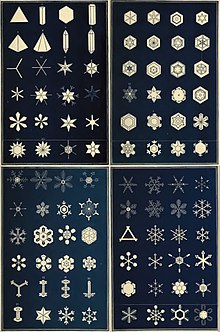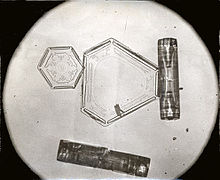User:Joayer/sandbox
Idea to combine the three different classification article sections from
Proposed consolidation[edit]

Snowflakes form in a wide variety of intricate shapes. Although nearly-identical snowflakes have been made in a laboratory, they are unlikely to be found in nature.[2][3][4][5] Initial attempts to find identical snowflakes by photographing thousands of them with a microscope from 1885 onward by Wilson Alwyn Bentley found the wide variety of snowflakes that are known about today.
Ukichiro Nakaya developed a crystal morphology diagram, relating crystal shape to the temperature and moisture conditions under which they formed[6][7] . Nakaya also discovered that shape is additionally influenced by whether the vapour pressure is above or below saturation. Below saturation, crystals trend more towards solid and compact. Under supersaturated conditions, shapes trend towards lacy, delicate, and ornate.
A summary of his findings is shown in the table below.
| Temperature range | Saturation range | Snow crystal type | |||
|---|---|---|---|---|---|
| °C | °F | g/m3 | oz/cu yd | below saturation | above saturation |
| 0 to −3.5 | 32 to 26 | 0.0 to 0.5 | 0.000 to 0.013 | Solid Plates | Thin Plates
Dendrites |
| −3.5 to −10 | 26 to 14 | 0.5 to 1.2 | 0.013 to 0.032 | Solid Prisms
Hollow Columns |
Hollow Columns
Needles |
| −10 to −22 | 14 to −8 | 1.2 to 1.4 | 0.032 to 0.038 | Thin Plates
Solid Plates |
Sectored Plates
Dendrites |
| −22 to −40 | −8 to −40 | 1.2 to 0.1 | 0.0324 to 0.0027 | Plates | Columns |

Depending on the atmospheric conditions and ice nuclei, more complex growth patterns also form side-planes, bullet-rosettes, and planar types.[8][9][10] For instance, if a crystal started forming in a column growth regime (at around −5 °C/23 °F) and then falls into the warmer plate-like regime, plate or dendritic crystals sprout at the end of the column, producing so-called "capped columns".[7]
Magono and Lee devised a classification of freshly formed snow crystals that includes 80 distinct shapes[11]. The main categories are:
| Crystal Category | Symobol | Subdivision |
|---|---|---|
| Needle | N |
|
| Columnar | C |
|
| Plate | P |
|
| Columnar and plate combination | CP |
|
| Side planes | S |
|
| Rimed | R |
|
| Irregular | I |
|
| Germ | G |
|
The International Classification for Seasonal Snow on the Ground describes snow crystal classification, once deposited on the ground, including grain shape and grain size. The system also characterizes the snowpack, as the individual crystals metamorphize and coalesce.[12]
- ^ Warren, Israel Perkins (1863). Snowflakes: a chapter from the book of nature. Boston: American Tract Society. p. 164. Retrieved 2016-11-25.
- ^ Kenneth G. Libbrecht. "Identical-Twin Snowflakes".
- ^ Cite error: The named reference
John Roachwas invoked but never defined (see the help page). - ^ Jon Nelson (2008-09-26). "Origin of diversity in falling snow" (PDF). Atmospheric Chemistry and Physics. 8 (18): 5669–5682. Bibcode:2008ACP.....8.5669N. doi:10.5194/acp-8-5669-2008. Archived (PDF) from the original on 2011-11-20. Retrieved 2011-08-30.
{{cite journal}}: CS1 maint: unflagged free DOI (link) - ^ Libbrecht, Kenneth (Winter 2004–2005). "Snowflake Science" (PDF). American Educator. Archived from the original (PDF) on 2008-11-28. Retrieved 2009-07-14.
- ^ Bishop, Michael P.; Björnsson, Helgi; Haeberli, Wilfried; Oerlemans, Johannes; Shroder, John F.; Tranter, Martyn (2011). Singh, Vijay P.; Singh, Pratap; Haritashya, Umesh K. (eds.). Encyclopedia of Snow, Ice and Glaciers. Springer Science & Business Media. p. 1253. ISBN 978-90-481-2641-5.
- ^ a b Cite error: The named reference
natgeojan07was invoked but never defined (see the help page). - ^ Matthew Bailey; John Hallett (2004). "Growth rates and habits of ice crystals between −20 and −70C". Journal of the Atmospheric Sciences. 61 (5): 514–544. Bibcode:2004JAtS...61..514B. doi:10.1175/1520-0469(2004)061<0514:GRAHOI>2.0.CO;2.
- ^ Kenneth G. Libbrecht (2006-10-23). "A Snowflake Primer". California Institute of Technology. Archived from the original on 2009-07-10. Retrieved 2009-06-28.
- ^ Kenneth G. Libbrecht (January–February 2007). "The Formation of Snow Crystals". American Scientist. 95 (1): 52–59. doi:10.1511/2007.63.52.
- ^ Magono, Choji; Lee, Chung Woo (1966). "Meteorological Classification of Natural Snow Crystals". Journal of the Faculty of Science. 7. 3 (4) (Geophysics ed.). Hokkaido: 321–335. hdl:2115/8672.
- ^ Fierz, C.; Armstrong, R.L.; Durand, Y.; Etchevers, P.; Greene, E.; et al. (2009), The International Classification for Seasonal Snow on the Ground (PDF), IHP-VII Technical Documents in Hydrology, vol. 83, Paris: UNESCO, p. 80, archived (PDF) from the original on 2016-09-29, retrieved 2016-11-25
